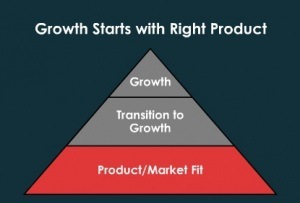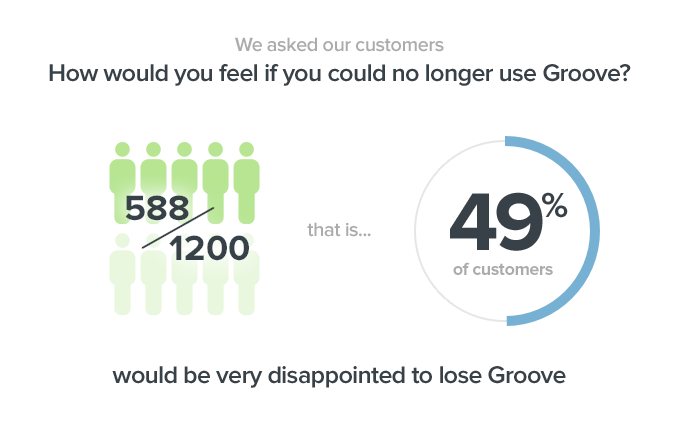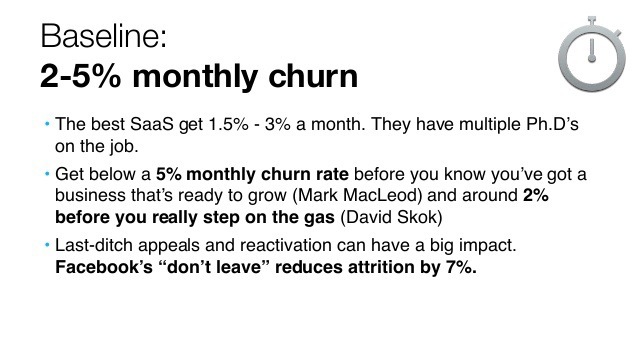What business metrics to use, and when: analyze your SaaS startup
- Transfer

As you may already know, there are many metrics and key performance indicators that are usually determined in order to understand how successful our business is. Nevertheless, we are very often lost and cannot understand which of them are really important, and, as a result, we pay a lot of attention to completely useless metrics.
There are several key metrics in the SaaS business that should be the focus. However, it is worth noting that the importance of these metrics changes in the process of developing and growing your business. If only three months have passed since you had clients who generate revenue, then determining the LCV or the customer’s Lifetime Customer Value will not be entirely appropriate. But at later stages of development, the LCV indicator becomes a key metric.
[ It is worth noting that understanding the key indicators of your business today is one of the main conditions for attracting investment. We talked about this here and here . ]
We will discuss in detail each of these stages of development, as well as which metrics should be given the main attention, and in the process of getting acquainted with the material you will understand that:
Working with a small number of key metrics, you can identify the most important problems that you should pay attention to and which must be solved in order to raise your business to the next level.
Any information will be useless if you do not take it into account when organizing activities. The metrics that you focus on will show how efficiently your company is operating at the moment, and tell you what to do first.
At each stage of your business development, there are two metrics that cancel each other out. Paying more attention to precisely these indicators, you will avoid unnecessarily optimizing a single metric and reducing business performance in the future.
Stage 1: Actions before / immediately after the release of a new product
And ensuring the product matches the market.
So, you have decided to develop your startup and plan to conquer the world market. But before you start building your Death Star , you need to make sure that you have chosen your product correctly and that it is most suitable for the corresponding market.
When launching a new product on sale, there may well be a contradiction between what you offer and the market situation, and your product will not be in great demand. In this case, you are either changing the product, or looking for a different target audience. Until you create the optimal situation when the product will be in demand in the target market, you need to achieve what we call “product-to-market matching” (this topic is discussed in detailBy Sean Ellis in this article).

Figure: The name of the scheme is “Company growth begins with choosing the right product”; steps of the pyramid from bottom to top: “Stage of product conformity to the market”, “Transitional stage”, “Stage of growth”.
The fact that your company is in the first stage can be determined by the following criteria:
- You are just starting your business.
- You are still looking for the perfect target audience.
- Site users / visitors experience or use your product for the first time.
These are difficulties that must be overcome first. But if you do not have the necessary information, then how can you determine the success of your activities at this stage?
At this stage, the use of research methods such as A / B testing will not help in determining the effectiveness of your business model, since you do not yet have (or not so many) customers who generate income and allow you to collect the necessary information. And the best way to do this is to conduct a qualitative analysis .

In the course of a qualitative analysis, you must do the following: check the effectiveness of the main business strategies in the process of communicating with representatives of your target audience. If they place orders for your products before you start selling them, then you are on the right track. [We gave examples of this approach here . ]
At the same time, at least 40% of respondents must report that they will be unhappy if they can not use your product.
What metrics are important at this stage?
1. Qualitative assessment
And although this is not a metric at all, it is practically the only information that you can get at this stage, because for some time you will have few orders for products, if any. Your goal now is to create the right product and offer it in a suitable market.
And the quickest way to do this is to start a dialogue with potential customers and other customers.
If at this point you already have a certain number of clients, you can talk to them via Skype and then analyze the results of the focus group survey. So you can get a better idea of the wishes of your customers and find out how they would solve problems that are relevant to you.
After that, you can offer your solution, which you are developing, and find out if they consider it correct and effective.
Start with a survey of 10-20 people according to this scheme:
- Learn more about reviewers by collecting the simplest demographic data.
- Discuss in detail with them the problems that they (like you) seek to solve.
- When you offer your solution, do not try to sell the product, but just ask customers to give their assessment.
If at this stage you do not have customers (it does not matter if they bring income or not), then you can talk with people who could be interested in your product. So you can analyze the various target markets. After all, it’s easier to do ten Skype interviews than to re-create a brand or product.
2. Evaluation of the conformity of the product to the market.
Let's go back to our installation number 2: “At least 40% of respondents must say that they will be unhappy if they can not use your product.”
Undoubtedly, assessing the conformity of a product to the market is an extremely complex process, and here we are not building illusions. How to find out that people are really interested in your product? Will you focus on positive reviews and not notice negative ones because you are so confident in the success of your business?
This problem can be easily solved with the help of an excellent question that you can ask your customers:
How do you feel about the fact that you can no longer use our product?
- You will be very unhappy
- Will be slightly unhappy
- You won’t worry (the product is not very useful)
- Unanswered question / I am no longer using your product.

Figure: “We asked our customers a question:“ How do you feel about the fact that you can no longer use our product? ” "588 out of 1,200 said they would be very unhappy if they lost the ability to use Groove, accounting for 49% of customers."
For example, if 50 people use your software product (its free, trial, or paid version), then send a questionnaire to those who have used your service at least twice in two weeks. This will allow you to quantify (and qualitatively) determine what your product will provide you with stable and substantial business development.
If less than 40% of the respondents gave such an answer, then it is very likely that it will be difficult for you to promote the product on the market, but, nevertheless, the results of the survey will help you plan your activities correctly and prepare your product in such a way as to achieve a better fit of the product to the market.
It can be difficult to ensure that the product matches the market, but getting feedback from the first users in the process of personal communication with them or working with the focus group via Skype will help you develop your business in the early stages, because your customers can give you a lot of useful ideas.
Stage 2: Your business began to grow
And then you have achieved a product match the market. What to do now?
At this stage, you are already earning income, and your customer base is increasing, so it's time to pay attention to the numbers. Now that your product is in demand in the relevant market, you can evaluate your progress using two metrics that will allow you to direct your activities in the right direction.
Your business expands if:
- You have found one or more ways to constantly attract new customers.
- A high percentage of customers keeps a subscription on your site, and these users are interested in continuing to pay for your services.
- Your monthly income is constantly increasing
At this stage, your main goals are:
- Continuous increase in monthly income and optimization of customer churn rate.
- Reducing the monthly coefficient of outflow of customers to 2% (up to 1%, if possible). If the coefficient is more than 5%, make every effort and use all the resources to solve this problem, so that in the end it is no more than 1%.
3. Monthly Recurring Revenue (MRR)
For many SaaS businesses, monthly income is a more important metric than traditional income. Being a kind of “Holy Grail” among all metrics for many entrepreneurs, the MRR indicator determines the effectiveness of your SaaS business.
By definition, MRR is the total monthly income from regular user contributions. By tracking the value of this indicator, you will understand the degree of success of your business from month to month.

Chart: vertical jackal - income; horizontal scale - time periods (product launch on the market, 1st month, 2nd month, etc.); legend: white color of the columns - MRR, yellow - additional MRR in the new month, orange - increase in the volume of additional MRR in the new month.
However, no one says keeping track of MRR is easy. To do this, it is necessary to ensure the following: it is very important to monitor this indicator on a monthly basis. The total revenue from users for the year must be distributed by month, and you need to consider not only the month in which customers subscribe.
For instance:
- Your annual rate is 300 $
- Monthly - $ 25
If according to the plan 5 people in January subscribe to use your service during the year, and 5 users subscribe for a month, then your income for January will be $ 1625.
Now consider the case if in February new subscribers did not appear. Your February income is $ 125, i.e. $ 5x25. If you compare the income for two months, you might think that your income decreased in February. But in fact, it turns out that you have a stable income, since the number of your subscribers who make contributions in these months has not changed.
Tracking revenue increases and decreases can be a tedious job. If the client decides to add $ 10 to the monthly installments, you need to add $ 10 to the MRR value.
The amount of planned income should be reduced if the client refuses to use your service.
4.
Outflow coefficient of clients The reverse side of the coin is the outflow of customers. It is perhaps the most well-known term among entrepreneurs that describes the most undesirable phenomenon: the outflow of customers means that your users decide that it will be better for them to no longer do business with you.
If users begin to cancel their subscriptions, then very soon your MRR will stop increasing, and, accordingly, your business will stop developing. As serial entrepreneur Ash Maurya said : “It's no wonder that those involved in the SaaS business are so obsessed with optimizing the level of customer churn.”
Meanwhile, the indicator of customer churn is a rather ambiguous metric. In the first stages, a 10% monthly outflow rate does not seem so great. 10% of 100 users is 10 people, and if you lose them, then you will still have 90 regular customers. Nothing serious, you say. You will easily find 10 new customers.
But let's raise the bar a little higher and consider the situation when you already have 10,000 subscribers. Do not you think that the loss of 1000 customers per month will not greatly affect your business? I must say right away that even for leading companies it will not be easy to maintain their business with such a high rate of customer churn.

The text of the picture: “The optimal value of the monthly outflow of customers: from 2 to 5%.
For the most successful SaaS companies, this figure is 1.5-3% per month. They have real scientists working on it;
Try to achieve an indicator not exceeding 5% before your business is ready for development (Mark McLeod) and 2% before your company begins rapid growth (David Skok);
Repeated confirmation of unsubscription can greatly affect the level of outflow of customers. For example, on Facebook, messages that appear when you delete your account can reduce the outflow rate by 7%.
Do not be confused by how easy and painless it is to manage the level of customer churn in the first stages, as it can easily increase and get out of control if you do not carefully monitor it. You need to tightly control the outflow indicator in order to form a reliable customer base that will ensure the stable development of your company over time.
According to Mark Saster : “Ideally, you need to conduct a survey among your customers and find out why they are unsubscribing.” If you talk with customers and find out why they decided not to cooperate with you anymore, you will have valuable information that you can use to improve your product and customer service.
These two metrics, in fact, are only the tip of the iceberg, and there are a few more indicators that you should focus on in the process of developing a business. You should remember how important it is to devote enough time to analyzing the state of your business, otherwise you will be wasting your time on useless e-mail messages and compiling reports on the activities of the company.
Many entrepreneurs make the mistake of focusing all their efforts on taking the business to the next level, finding good specialists and investing as much money as possible, but at the same time they forget or, worse, don’t attach importance to optimizing the right metrics that need to be tracked, to know if your business is developing or not.
At this stage, it will be very correct to analyze the current state of your business and compare it with the state of other firms from the same market segment or industry, the same in size and at the same stage of development. If you can conduct such an analysis, then this is very good, but the main condition for achieving real success is the development of approaches and strategies that are effective specifically for your SaaS business.
PS More about the relevant metrics and structuring of information about your business in a presentation template prepared by IIDF experts [ Slideshare , Keynote , PPT ]:
